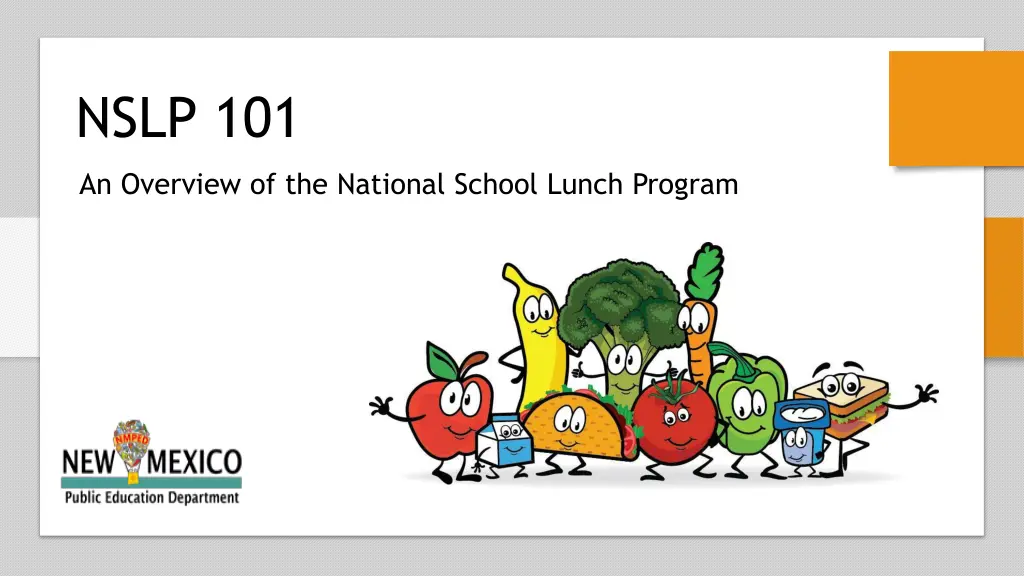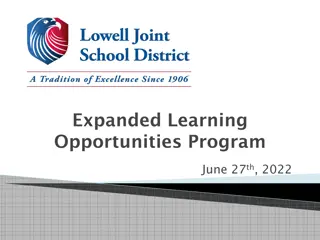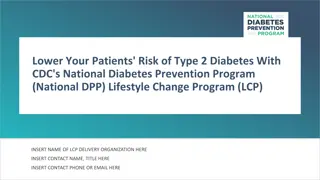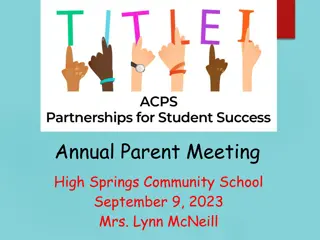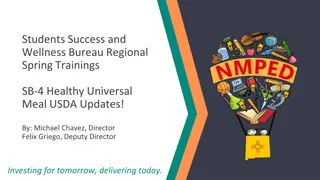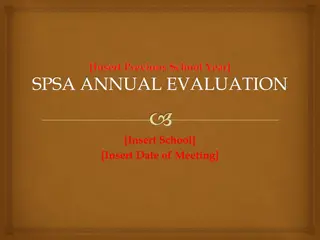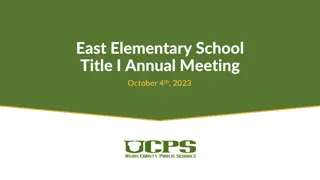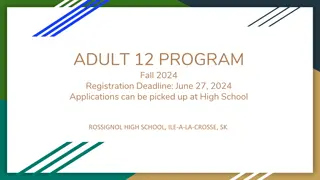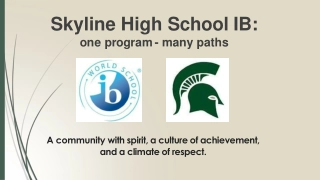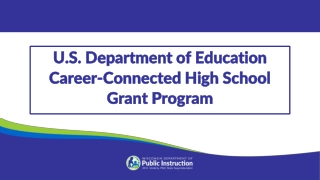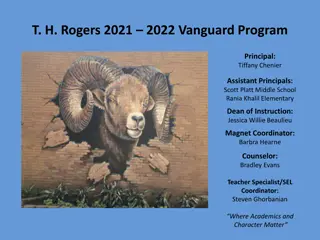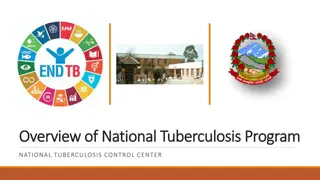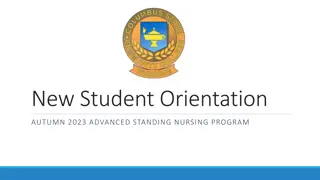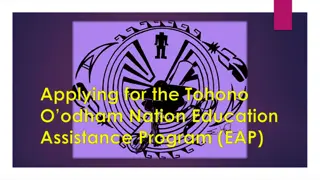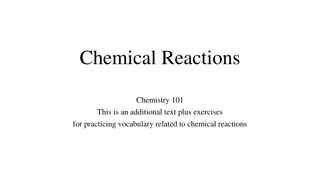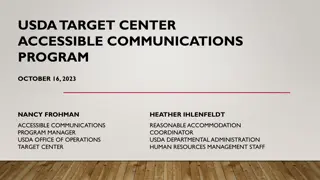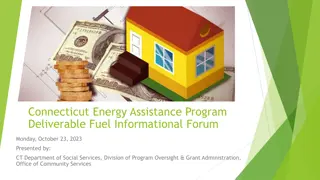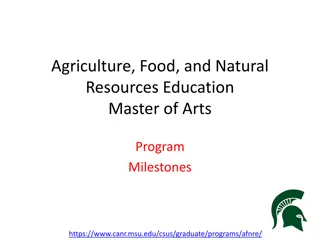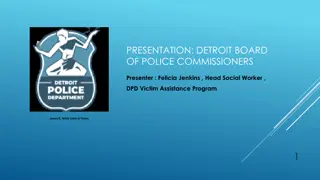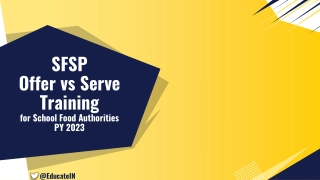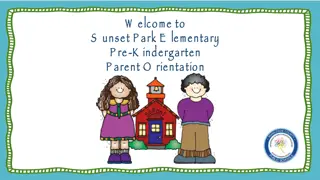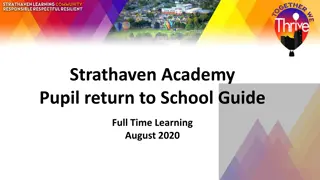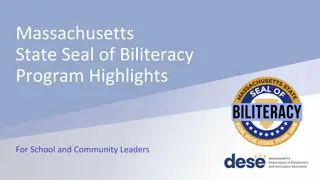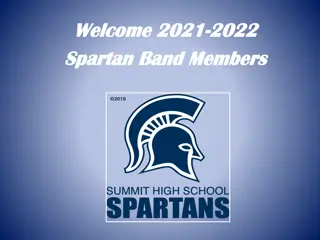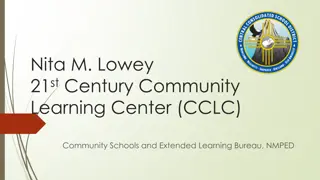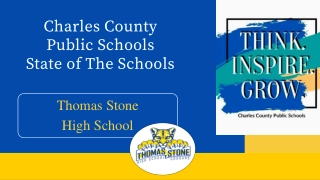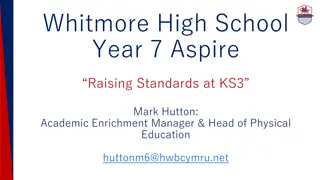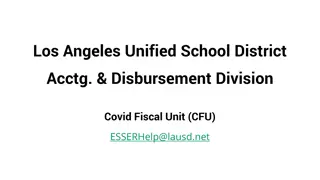NSLP 101: An Overview of the National School Lunch Program
The National School Lunch Program (NSLP) is a federally funded program providing nutritionally balanced, low-cost or free lunches to school children each school day. School Food Authorities (SFAs) ensure meals meet federal requirements without discrimination. Guidelines include offering meal components, meeting serving sizes, using whole grains, and limiting saturated fat and sodium. The program also includes the School Breakfast Program (SBP) offering breakfast to students.
Download Presentation

Please find below an Image/Link to download the presentation.
The content on the website is provided AS IS for your information and personal use only. It may not be sold, licensed, or shared on other websites without obtaining consent from the author. Download presentation by click this link. If you encounter any issues during the download, it is possible that the publisher has removed the file from their server.
E N D
Presentation Transcript
NSLP 101 An Overview of the National School Lunch Program
Program Overview The National School Lunch Program (NSLP) is a Child Nutrition Program, federally funded and administered by the United States Department of Agriculture Food and Nutrition Service. NSLP operates in public and nonprofit private schools and residential childcare institutions (RCCIs). The program provides nutritionally balanced, low-cost or free lunch to school children each school day. The program was established under the National School Lunch Act, signed by President Harry Truman in 1946. At the state level, the New Mexico Public Education Department, Student Success and Wellness Bureau is the administering agency that works with schools and other sponsoring organizations to provide nutritious meals, and snacks for children. Reimbursement is provided in three levels (Free, Reduced-Price and Paid) to the School Food Authority (SFA) for each meal that meets the federal requirements and is served to an eligible school child.
School Food Authorities (SFAs) that participate in the NSLP and other school-based child nutrition programs, agree to: Serve meals that meet federal program requirements Operate a nonprofit food service program Offer free, reduced-price and paid meals to eligible children based on household eligibility Not overtly identify or discriminate against any eligible child Offer school nutrition programs for all students without regard to race, color, national origin, sex, age, disability, religion, ancestry, and/or sexual orientation
Reimbursable school lunch meals must meet the following guidelines: Offer 5 meal components (grain, meat/meat alternate, fruit, vegetable & milk). Servings of grains must meet daily and weekly minimum serving sizes. 80% of grains offered weekly, must be whole grain rich Servings of fruit must meet daily and weekly minimum serving sizes. Servings of vegetables must meet daily and weekly minimum serving sizes from each of the specified vegetable subgroups. Servings of meat/meat alternates must meet daily and weekly minimum serving sizes. 2 types of milk must be offered. Milk must be fat-free (skim) or low-fat (1%) and may be flavored or unflavored. Meals must adhere to minimum and maximum average calorie range for the week. Calories from saturated fat cannot exceed 10% of total calories. Meals must meet sodium limitations (Sodium Interim Target 1A) If the school is participating in Offer versus Serve, a reimbursable meal must have at least 3 of the 5 food components; one of which must be at least a cup fruit OR vegetable.
The School Breakfast Program (SBP) is a federally funded meal program operating in public and nonprofit private schools and residential childcare institutions. It provides nutritionally balanced, low-cost or free breakfast to school children each school day.
Reimbursable school breakfast meals must meet the following guidelines: Offer four items from three required components (grain, fruit or vegetable, milk). Servings of grains must meet daily and weekly minimum serving sizes. 80% of grains offered weekly, must be whole grain rich Servings of fruit must meet daily and weekly minimum serving sizes. 2 types of milk must be offered. Milk must be fat-free (skim) or low-fat (1%) and may be flavored or unflavored. Meals must adhere to minimum and maximum average calorie range for the week. Calories from saturated fat cannot exceed 10% of total calories. Meals must meet sodium limitations (Sodium Interim Target 1A) If the school is participating in Offer versus Serve, a student must select at least 3 items (not components); one of which must be at least a cup of fruit, to make a reimbursable meal. OVS is optional for breakfast, for all grades.
The Seamless Summer Option (SSO) combines features of the NSLP, SBP, and the Summer Food Service Program. This option reduces the paperwork and administrative burden making it easier for schools to feed children from low-income areas during the traditional summer vacation periods. Other Programs The After School Snack Program (ASSP) provides reimbursement for snacks provided to school children participating in structured enrichment programs after the school day ends. Schools with 50% or greater free and reduced-price eligible students, or in the attendance area of a school with 50% or greater free and reduced-price eligible students, may provide the snacks at no charge to any participating student.
USDA Fresh Fruit & Vegetable Program (FFVP) FFVP is a supplemental program that offers fresh fruits and vegetables at no charge to students outside of school meal serving times. FFVP is targeted to elementary schools which have the highest Free and Reduced enrollment. Each Spring all interested schools must apply by completing an application and submitting it to the NMPED. Awarded schools receive funding at ~$50-$75 per student to implement the program the following school year.
NSLP Meal Pattern Requirements The lunch meal pattern must offer foods from all five meal components.
Grade Groupings The USDA National School Lunch Program (NSLP) and School Breakfast Program (SBP) meal patterns have three grade groupings: K-5 6-8 9-12 Each of the grade groups has specific meal pattern requirements that must be met. Requirements for the K-5 and 6-8 grade groups overlap, allowing a school that has overlapping grades in K-5 and 6-8, or a K-8 school, to plan to serve the same amount of food for the entire school. The 9-12 grade group does not have overlapping requirements with the two younger grade groups. This means that a school that is K-12, would need to be prepared to serve at least two grade groups, K-8 and 9-12.
Meal Components Meal components are food groups established by USDA to provide the basis for the meal patterns used in menu planning. Each component is based on the nutrient content of foods in each category.
Meat/Meat Alternates Meat and meat alternates include beef, pork, poultry, fish, eggs, cheese, nuts and seeds, nut and seed butters, beans and legumes, cottage cheese, and yogurt. In addition, tofu and soy yogurt may be credited as a meat/meat alternate provided they are commercially made and credit as follows: Tofu - 2.2 ounces or cup of commercially prepared tofu must contain at least 5 grams of protein and the cup portion will equal 1 oz. of meat/meat alternate. Soy yogurt - cup of liquid volume is credited as 1 oz. of meat/meat alternate. *When crediting beans and legumes as a M/MA component, they cannot also be credited as the vegetable subgroup in the same meal.
Grains At least 80% of grains offered weekly, must be whole grain rich, the remaining 20% must be enriched. Whole grain rich products are those that contain 100% whole grain or a 50/50 blend of whole grain and enriched grains. This Photo by Unknown Author is licensed under CC BY-SA-NC This Photo by Unknown Author is licensed under CC BY-SA-NC
Ounce Equivalencies for Grains As stated in USDA Memo SP-2012 Grain Requirements for the National School Lunch Program and School Breakfast Program, grain products must be credited using the oz eq method. This criterion is applied to various products as follows: Baked goods, such as breads, biscuits, bagels, etc., require 16 grams of creditable grain ingredients in order to provide 1 oz eq credit. For cereal grains such as oatmeal, pasta, and brown rice, etc., a 1 oz equivalent is 28 grams (approximately 1 oz by weight) of dry product. Since these grains are served cooked and water is added in preparation, the cooked volume equivalent is cup cooked cereal, pasta, or rice. For ready-to-eat (RTE) breakfast cereal, 28 grams or 1 oz of product is considered an ounce equivalent. The oz equivalent volumes are 1 cup flakes or rounds, 1.25 cups puffed cereal, and cup granola.
Serving a variety of fruit in different forms is strongly encouraged as offering a choice increases the likelihood that more students may select and eat one. Fruit may be fresh, frozen, canned, or dried. While there is a daily minimum, there is no maximum limit for the amount of fruit servings offered. Canned fruit must be in 100% juice, light syrup, or water. When dried fruit is offered, the amount credited is twice the amount served (ex: cup raisins credits as cup). 100% fruit juice may be used to meet no more than half of the weekly fruit requirement.
Vegetables Choices from the following vegetable sub-groups must be served in minimum amounts over the course of the week. *For raw leafy greens, such as lettuce, 1 cup credits as a cup of the vegetable component. *Dried beans and legumes may be used as either a vegetable or a meat/meat alternate but NOT BOTH in the same meal.
Milk Fluid milk must be offered daily At least two milk choices must be offered from the following options: unflavored 1% milk unflavored fat-free milk or flavored fat-free milk. **For students who are lactose intolerant, a reduced lactose or lactose free milk may be provided. This is specially treated cow s milk so it is an acceptable substitute. For those who cannotdrink cow s milk, only approved milk substitutes can be provided.
Offer versus Serve (OVS) in Lunch OVS is a requirement of NSLP for all high schools, and is optional for lower grades. OVS requires that all 5 food components (grains, meat/meat alternate, fruit, vegetables and milk) be offered in the required quantities and students may decline 1 or 2 of the 5 required components. Students must select at least 3 of the required components, one of which must be at least cup of fruit and/or vegetable.
SBP Meal Pattern Requirements The breakfast meal pattern must include food from three meal components (grain, fruit and milk).
Fruit (breakfast) One (1) cup of fruit must be offered each day and students must select a minimum of a cup equivalent for the breakfast to be reimbursable. *Vegetables may be substituted for fruit. *If offering a starchy vegetable, you must offer an additional two cups of vegetables from another subgroup (dark green, red/orange, beans and peas (legumes) and other. *One quarter cup of dried fruit counts as cup fruit and 1 cup of leafy greens counts as cup of vegetables. *No more than half of the fruit or vegetable offerings may be in the form of juice. All juice must be 100% full strength.
Grains/Bread If grain components are offered in amounts larger than the minimum serving size amount of 1 oz. eq, and equal full oz. equivalent serving amounts, such as a 2 oz. eq muffin, or a 3 oz eq. bagel, then the menu planner has the option to count it as either 1, 2 or 3 items for Offer versus Serve. Items that are larger than 1 ounce but not full ounce equivalents, like a 1.5 ounce cinnamon roll, this would count as a 1 ounce food item in Offer versus Serve (OVS).
Meat/Meat Alternate (optional) It is not a requirement to offer a meat/meat alternate as part of the School Breakfast Program. Schools do have the option of offering a meat/meat alternate after the minimum 1 oz. eq daily grain requirement is offered. In this instance, a 1 oz. equivalent of a meat/meat alternate may credit as the additional 1 oz. equivalent of grain. Schools also have the option of offering a meat/meat alternate as an additional food and not credit it toward any component. With respect to OVS, grains and meat/meat alternates must be offered and served in full ounce equivalents to count as an item.
Milk Fluid milk requirements are the same for breakfast as they are for lunch. At least two milk choices must be offered from the following options: unflavored 1% milk unflavored fat-free milk or flavored fat-free milk. **For students who are lactose intolerant, a reduced lactose or lactose free milk may be provided. This is specially treated cow s milk so it is an acceptable substitute. For those who cannotdrink cow s milk, only approved milk substitutes can be provided.
Offer versus Serve (OVS) at Breakfast OVS is optional for all grades in the School Breakfast Program. To carry out this option, schools must offer at least 4 items from the 3 required meal components (grains, fruit and milk). Students may decline 1 item but must select at least cup of fruit and at least 2 other items. When counting meals for reimbursement, it is important for the cashier or person taking the meal count be able to identify whether each student has taken the minimum amount to make a reimbursable meal.
Menu Planning The menu is the core of NSLP and must list all food items offered to students as part of a reimbursable meal. When planning the menu, the menu planner must follow meal based menu planning . Planners should consider he foods currently available in inventory, USDA Foods, as well as the food service budget.
Menu Planning Checklist Determine number of days to be planned. Check your inventory. What food is currently on hand? What USDA foods will be delivered during the month for which you are planning? Consider meal participation for previous menus. Consider culturally acceptable foods. Focus on grade group(s) to be served. Decide on the number of entr e choices to be offered. Consider the equipment, or lack thereof, in the kitchen. Select the entr e for each day being planned. Select the other required meal components. Keep in mind the NSLP requirement to offer a variety of vegetable subgroups throughout the week. Ensure at least 2 milk choices are offered. Make sure the daily and weekly minimum serving sizes are met for each component. Consider marketing ideas, menu themes, school events, and seasonal items. Consider the condiments you may wish to offer with the meal.
After-School Snack Program Meal Pattern Afterschool snacks must contain at least two different components of the following four: a serving of fluid milk; a serving of meat or meat alternate; a serving of vegetables or fruits or 100 % vegetable or fruit juice; a serving of whole grain or enriched bread or cereal. Note: The serving size of fruits/vegetables is cup for school-aged children (ages 6-12) Juice may not be served when milk is served as the only other component For students ages 13-18, follow the ages 6-12 guidelines you may choose to offer more
Requirement to Post Menus Schools are required to post the breakfast and lunch menu near the beginning of the meal service line(s) so students know what foods can be selected as part of complete a reimbursable meal. They also need to include the requirement to select a minimum cup fruit or vegetable with a meal. Menus do not need to include foods that are only served as an a la carte option. This requirement can be satisfied in the form of a written daily or weekly menu, through use of a sample/display tray, or by a menu poster.
Production Records Federal Regulation (7 CFR Section 210.10(a)(3)) stipulates that Production and menu records shall be maintained to demonstrate that the required number of food components and food items or menu items are offered on a given day. Production records shall include sufficient information to evaluate the menu s contribution to the requirements on nutrition standards and the appropriate levels of nutrients and calories whichever is applicable. Production records are required to be kept for the School Breakfast Program, National School Lunch Program and the After School Snack Program. They support the claiming of reimbursable meals, provide a historical record of meal service and serve as a tool to monitor food cost.
Production records should include the following information: Name of the Site Date If the site participates in Offer Versus Serve (OvS) Grade groups being served (K-5, 6-8, K-8, 9-12 ) Daily Menu and food items (including condiments & leftovers from another day) Recipe Number or Product Brand Name Planned Portions sizes Quantities Prepared/Total projected servings Contribution to food components Actual Student Servings and Actual Other Servings (adult, a la carte) Amount Leftover
Non-creditable Foods Often there are foods that do not contribute to meeting meal pattern requirements but are added to a meal for interest and/or flavor. Examples are salad dressings and sandwich condiments. It is commonly known that these items are non-creditable, meaning they do not contribute to meal pattern requirements. However, there are other foods that are less obvious. For example, cream cheese is sometimes thought of as a meat/meat alternate. However, it has too little protein to count as part of the meat/meat alternate group. You are allowed to serve non-credible foods, just remember that they will count toward the weekly calorie limits. Examples of non-credible foods include: Bacon Bacon Bits Butter/Margarine Cream Cream Cheese Condiments & dressings Ice Cream/Frozen Yogurt Minced fish Popcorn Pepperoni Potato Chips Popsicles Pudding Salami
Smart Snacks in Schools All schools participating in the National School Lunch and/or School Breakfast Program are required to follow the Smart Snacks Nutrition Standards. These standards apply to all foods and beverages sold to students during the school day, outside of, or in addition to, the reimbursable meal. These includes items sold a la carte as well is in vending machines, school stores and fundraisers. These standards apply during the school day anywhere on school campus/grounds that students have access to. A school day is defined as midnight to 30 minutes after the end of the school day.
Is that a Smart Snack? Alliance for a Healthy Generation has developed a Smart Snacks Calculator that can be used to determine whether the snacks being sold to students meet the standards. To use the calculator, you will need the nutrition label. Once you have entered the data, the calculator does the math and tells you if your snack meets the standards. If it does not meet the standards, it tells you the unmet standard(s). The Smart Snacks Calculator can be found here: https://schools.healthiergeneration.org/focus_areas/snacks_and_beverages/ smart_snacks/
Smart Snacks Nutrition Standards for Beverages All schools may sell: Plain water (with or without carbonation) Unflavored low fat milk Unflavored or flavored fat free milk and milk alternatives permitted by NSLP/SBP 100% fruit or vegetable juice and 100% fruit or vegetable juice diluted with water (with or without carbonation), and no added sweeteners. Elementary schools may sell up to 8-ounce portions, while middle schools and high schools may sell up to 12-ounce portions of milk and juice. There is no portion size limit for plain water. nocalorie and lower calorie beverage options may be sold to high school students. No more than 20-ounce portions of oCalorie-free, flavored water (with or without carbonation); and oOther flavored and/or carbonated beverages that are labeled to contain < 5 calories per 8 fluid ounces or 10 calories per 20 fluid ounces. No more than 12-ounce portions of o Beverages with 40 calories per 8 fluid ounces, or 60 calories per 12 fluid ounces. Additional Smart Snack Requirements Fundraisers Fundraisers that sell food items to students at school during the school day must meet the same standards as for Smart Snacks. The Smart Snack nutrition requirements do not apply during non-school hours, on weekends and at off-campus fundraising events. Accompaniments Items such as cream cheese, salad dressing, and butter must be included in the nutrient profile as part of the food item sold.
Standard Standard Must collect FRL Applications Eligibility and benefit issuance determinations (FRL Application Income vs Direct Certification) Free, Reduced or Paid Verification of applications Required to complete and submit FNS-742 Community Eligibility Program (CEP) Community Eligibility Program (CEP) Minimum threshold of 40% ISP required to participate (% based on April 1 data) No FRL Applications required Must re-establish every four years Required to complete and submit FNS-742
Master List/Benefit Issuance List Master List/Benefit Issuance List Once eligibility has been determined, a list must be created and maintained to indicate which students are eligible for free and reduced meals. This is called a Master List or a Benefit Issuance List and is a roster of student names that includes information about student eligibility. This is a confidential confidential list and should be kept in a secure location. The list should contain: The list should contain: Student name Application number (recommended but not required) Grade Eligibility Date of eligibility determination Approval reason (income, DC, etc.) Status Change: date of change, eligibility changed to (F or R), reason for change, withdrawal date As updates are made to the list, do not remove any names. The Master List serves as a live document that provides a history of eligibility information for individual students over the entire school year. For example, if a student leaves school, that student s name should remain on the list. The date, status change, and reason will indicate a student is no longer eligible for meal benefits because he or she has withdrawn. All lists should be kept for 3 years plus the current school year. All lists should be kept for 3 years plus the current school year.
Point of Service Document Point of Service Document The Point of Service Document is a listing of currently eligible students that is used by food service staff at the point of service. Updated information from the Master List must be provided in a timely fashion to make sure the Point of Service Document is updated and the student receives the correct benefit. This may be a roster or checklist where eligibility status, if available, is listed in a form only identifiable to the person claiming the meals for reimbursement. This document must prevent overt identification eligibility category is protected and known only by those school officials who deal directly with the counting and claiming system. must prevent overt identification meaning the Replacement of Benefit Issuance Documentation Replacement of Benefit Issuance Documentation Depending on the benefit issuance documentation chosen, students may misplace or lose tickets, identification cards, etc. The USDA has issued specific instructions (FNS Instruction 765-7, Revision 2) regarding lost, stolen, or misused benefit issuance documentation. The purpose of this guidance is to assist sponsors in developing or revising district/school policies while ensuring compliance with federal regulations.
Accountability: Meal Counting and Claiming Accountability: Meal Counting and Claiming To receive reimbursement, sites must accurately count, record, and claim the number of reimbursable meals actually actually served to students by category: Free, Reduced and Paid. The number of meals served Free, Reduced and Paid claimed for reimbursement must have adequate documentation on file to support the claim. The meal counting and claiming system includes the following: Eligibility Documentation Collection Procedures Point of Service Counts Reports Claim for Reimbursement Internal Controls 1. 2. 3. 4. 5. 6. Each of the above elements are important; and all work together to provide accurate and acceptable documentation for meal reimbursement.
1. Eligibility Documentation 1. Eligibility Documentation - The SFA must have documentation to claim free or reduced- price meals for reimbursement. Documentation includes Free and Reduced Price School Meal Applications, Direct Certification list, homeless and/or migrant liaison list, Head Start list, and lists of residential students in RCCIs. 2. Collection Procedures 2. Collection Procedures Different systems may be used to collect payment for student meals. These include pre-payment, post-payment and payment at the Point of Service. Regardless of the means used to collect payment, the SFA must prevent overt identification to keep students eligibility for free or reduced meals confidential. 3. Point of Service Counts(for non 3. Point of Service Counts(for non- -special provision schools) Service (POS), the point in the food service line where it can be determined that a reimbursable meal, containing all required components, has been served to an eligible student. Alternative systems, including remote serving areas such as classrooms, must be pre-approved by the state agency. special provision schools) - Meals must must be counted daily at the Point of
4. Reports 4. Reports The numbers of reimbursable meals served daily, by category of eligible students are recorded and reported by personnel trained to observe and record reimbursable meals. Meal Count Edit Check - the SFA must evaluate the lunch meal counts for each site prior to submission of the Claim for Reimbursement. The Daily Record Form: School Lunch found on our website under Forms > Daily Operations Forms , will assist you in performing an edit check and will help identify and prevent errors in recording and consolidating meal counts. The process compares the daily number of free, reduced-price and paid lunches claimed for each site to the following: o Highest number of eligible students by category o Attendance-adjusted eligible students for each category The Daily Record Form: School Lunch also compares the monthly number of free, reduced and paid lunches claimed for each site to the maximum number of meals allowable to the total number of meals claimed by category. It is required that the meal count edit form is completed each month for sites participating in NSLP. When completing the meal count edit form normal rounding rules do not apply. Do not round up; leave the decimal should one occur during calculations.
The SFA shall promptly follow-up through phone contact, on-site visits or other means when the internal controls used by the school(s) or SFA for the claims process indicate the likelihood of meal count problems. When problems or errors are identified, the meal counts shall be corrected prior to submission of the monthly Claim for Reimbursement. Improvements to the meal count system shall be made to ensure that the meal counting system consistently results in meal counts of the actual number of reimbursable free, reduced and paid meals served for each day of operation. 5. 5. School Detail & Claim for Reimbursement School Detail & Claim for Reimbursement This is how SFAs report required information to receive subsidy payment for meals served. The monthly Claim for Reimbursement is submitted electronically by the SFA in the Nutrition Claims Portal New Mexico Student Nutrition Claims Welcome and Alerts (state.nm.us) 6. Internal Controls 6. Internal Controls - The SFA must establish internal controls to ensure an accurate Claim for Reimbursement has been made. Here are a few examples of internal controls: Segregation of duties On-site visits required to be completed for each site prior to February 1 of each year Reconciliation of production records to meals
Preventing Overt Identification Preventing Overt Identification A system for counting and claiming meals must prevent overt identification. This means the eligibility category of any child must be protected and known only by those school officials who deal eligibility category of any child must be protected and known only by those school officials who deal directly with the counting and claiming system. directly with the counting and claiming system. Codes on checklists, rosters or tickets are one method of preventing overt identification. A code must be difficult to recognize, but not so confusing that the person taking the count has difficulty identifying the category. Some codes are too easily recognizable and therefore allow overt identification. These include the actual words free, reduced-price and paid or the use of the letters F, R or P. In addition, the use of different colors for different designations is also prohibited.
Federal and State Regulations
